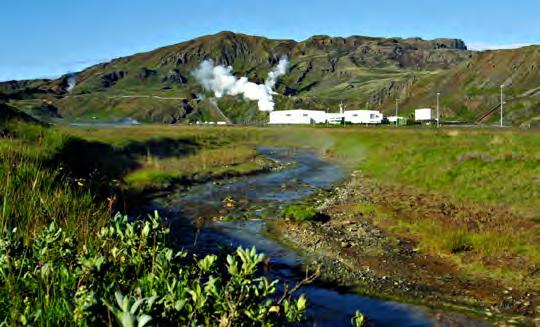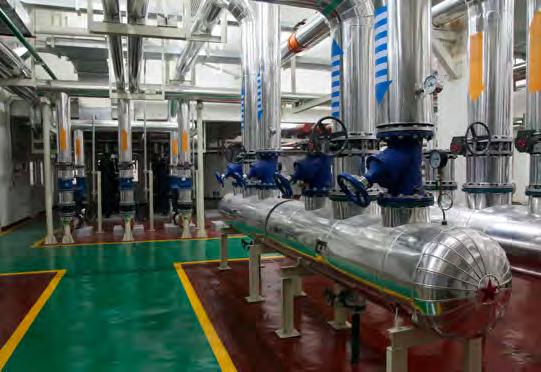
9 minute read
The Icelandic geothermal model is changing China
Arctic Green Energy’s joint venture with China’s Sinopec has become the world’s largest and fastest growing geothermal district heating company which is revolutionising China at a time of global warming
by Hallur Hallsson, Icelandic Times
12 A Piece of History In 1930 the people of Reykjavík – ‘Smokey Bay’ – began to use hot water coming from the ground to heat their houses. The tiny capital was given its name when the first settlers saw the steam rising from hot springs. Coal burning pollution had become a massive problem, so the locals were turning to the hot water to heat houses. Iceland was poor and isolated out at the furthest point in the North Atlantic. In the mid-thirties, Austurbæjarskóli, an elementary school in Reykjavík, became the first building to be heated with geothermal energy.
In August 1941 during World War II, Winston Churchill visited Iceland after meeting President Roosevelt to sign the Atlantic Treaty. During his visit to Iceland, Churchill put up the V-sign for victory for the first time. At that point, the Nazis ruled Europe, bombing London and English cities, while Japan ruled Asia and occupied China.
Churchill visiting geothermal pools in Iceland
The prospects were grim but changes were coming. Churchill marvelled at the locals’ use of hot water which, he believed, was a sign for the future. He visited Reykjadal – Smokey Valley – to the East of the capital where they were drilling for hot water. It was only natural to tap into it. The locals use had been limited basically to swimming in warm water pools and the women washing their laundry in the warm water around the country. That had been about it.
As houses were heated with the hot water, Reykjavík became the cleanest capital of the World. Little did they know that their drilling would springboard Iceland to the top of the world of geothermal energy. It would take time but slowly and surely the tiny nation progressed, though the road was quite bumpy at times.


The start. Fu Chengyu and Haukur Harðarson sign the agreement attended by China‘s Premier Wen Jiabao, Iceland‘s PM Jóhanna Sigurðardóttir and present PM Katrín Jakobsdóttir
Industrialisation based on green energy There are two main methods of harnessing geothermal energy. High temperature Geothermal with over 150° Celsius has traditionally been harnessed to generate electricity. The other method, the direct use of the geothermal water, is perhaps even more important and has been used for everything from house heating, to greenhouses, aquaculture and tourism.
In the late sixties – fifty years ago – Iceland was in a deep economic crisis as the herring had failed to migrate into Icelandic waters from the Norwegian Sea. Thousands of Icelanders migrated overseas, mostly to Sweden, but to Canada and Australia as well. Iceland was in the custody of the World Bank. However ambitious industrialisation plans started to transform the country as Iceland began harnessing its powerful glacier waters and built its first aluminium smelter.
In the late eighties construction began on the high-enthalpy geothermal system at Hengill Mountain by the Thingvellir National Park. The plant combined geothermal hot water for heating and an electricity generating power plant for Reykjavík. Nesjavellir geothermal power plant was in operation by 1990. Iceland had become the geothermal world leader and living standards rocketed to the top five with the abundance of energy. Electricity
President of Iceland Ólafur Ragnar Grímsson visited Sinopcec Green Energy
www.icelandictimes.com 13 generated from geothermal sources is now responsible for over 35% of Iceland’s primary energy generation, with the rest of the primary energy generated from hydroelectric. Iceland was, until recently, the only country around the globe that generated 100% of its primary energy from renewables. Now Costa Rica has become the 2nd country of this prestigious club. Higher life expectancy Since that time the geothermal district heating systems of Iceland have reached over 95% of all heated areas in the country. Geothermal is the only renewable energy that does not require batteries of some sort and therefore the only renewable suitable for heating and cooling cities, since there are no batteries that can handle such tasks. As Icelanders soon discovered, geothermal has brought many benefits to the environment, public health and the economy. Older Icelanders will still remember the smog that covered Reykjavík on still winter days and the pollution that accompanied the import and burning of coal to stay warm. Medical studies have shown a higher life expectancy materialising with the elimination of coal. Respiratory disease cases dropped fast. On the economic front, Iceland is now saving significant amounts of foreign currency that would have been required to replenish the coal supplies needed previously every winter. Arctic Green Energy’s partnership with Sinopec In 2006 Enex China – which became Arctic Green Energy – was originally established by Reykjavík municipality Power Company and partners. This effort was a direct result of former Chinese President Jiang Zemin visiting his Icelandic counterpart Ólafur Ragnar Grímsson, who showed him the Icelandic geothermal infrastructure. The mission of the new company was to export Iceland’s success and leadership in geothermal energy. The company in China was still small when Sinopec – the world’s 3rd largest company – acquired the Chinese partner in 2009 and Haukur Harðarson acquired Enex China in 2011.
Haukur Harðarson and the President of Iceland Ólafur Ragnar Grímsson

www.icelandictimes.com 14 Sinopec Green Energy was founded with the Chinese side holding 51% and the Icelandic side 49%. Milestone agreements for the rapid expansion of the partnership were signed in Reykjavík by the chairmen of Sinopec Group and Arctic Green Energy. The signing was witnessed by Prime Minister Jóhanna Sigurðardóttir and Katrín Jakobsdóttir who, in 2018, became Prime Minister in Iceland, along with Premier Wen Jiabao on the Chinese side. President Ólafur Ragnar Grímsson would visit Sinopec Green Energy in China. Iceland’s leaders were keen to follow Sinopec Green Energy’s journey as they believed the country had something special to offer the world. Phenomenal success Sinopec Green Energy’s success in China has been phenomenal; in fact, it has been revolutionising China just as geothermal energy revolutionised Iceland. SGE has become the world’s largest geothermal company and has drilled over 520 wells and started operations across 60 cities and counties in China; mostly in Hebei, Shaanxi, Shanxi, Shandong and Tianjin and is now working on Xiongan; China’s first “smog free city” emerging as a global showcase of sustainability.
“President Ólafur Ragnar Grímsson’s role in building the geothermal relationship between Iceland and all of Asia cannot be overstated,” says Haukur Harðarsson and continues. “As a head of state, he stood out among his peers as a man of vison and passion, with a strong credible voice for environmental affairs, long before it became fashionable. He has carried this torch with him to his new role as the chairman of the Arctic Circle, the global platform on Arctic Affairs. For us and our partners, the Arctic Circle Assembly has become our central and preferred platform when it comes to signing milestone agreements or sharing with the renewable energy world our work in China and elsewhere on the Eurasian continent.” China’s geothermal revolution Sinopec Green Energy operations have reduced CO₂ emissions dramatically. It’s the first geothermal company in China to apply large scale re-injection and owns some of the most valuable patents in the industry, including re-injection technology patents. SGE has close to 50 million square metres of heating capacity, serving more than 2,000,000 customers with 399 heat centres – all in just a few years. Sinopec Green Energy has proven that the most effective way of reducing air pollution and greenhouse emissions is to replace coal driven district heating systems with geothermal energy. Sinopec Green Energy is expanding to other branches of renewables in addition to geothermal. Geothermal will, however, as the only renewable available 24/7 and needing no battery storage, remain the backbone of such multiple renewable energy systems. Thus, Iceland’s expertise and leadership in geothermal and clean tech has been extremely beneficial to China.
SGE leadership in China is not only in its market share (about 40%) but also in having shaped the industry. Its projects in Xiongan are now the official showcases for harnessing geothermal energy for district heating and geothermal exploration. The company was the first geothermal company globally to get carbon trading accreditation by the UN. It was the first to introduce large scale geothermal reinjection of used geothermal brine and is today owner of over 50 patents. The green energy potential has really been a surprise and the first officially recognised smog free city in Xiongan New Area outside Peking will be a benchmark for the future. China is emulating Iceland’s miraculous rise to good effect and is itself being revolutionised by the Icelandic model.
The Icelander living in Saigon The man behind Arctic Green Energy, Haukur Harðarson, and his family have been living in Saigon, Vietnam since 1992 with intervals, this time since 2008. Harðarson is educated as an architect. One of his last projects in Iceland was the Stock Exchange building in Reykjavík.
Arctic Green is based in Singapore and is working on assignments in Vietnam, Singapore, Kazakhstan and moving into Europe and Central Asia, working – as in China – with local partners.
Icelandic Times met with Mr. Harðarson at AGE offices in Reykjavík. “The Sinopec Group and its subsidiaries are a brilliant partner and our co-operation has been exemplary. The Icelandic know-how is brought to the mix with results that really have been astounding. We’ve proven the concept. The geothermal solution, as one of the more important parts of the global green energy transition, is not only a viable way to take down the pollution-spewing chimneys but the most effective weapon in the global fight against air pollution and climate change.”
Mr. Harðarson points out that approximately half of all energy generation is for heating. Cities consume 70% of all energy consumed and most of that is for the purposes of heating. As an example, when the energy use of an average home in the Northern hemisphere is studied, we find that over 80% is only for heating and hot water. The lights

and the various electric appliances are only responsible for under 20%. “It goes without saying that it’s a huge challenge to reduce carbon energy heating in our homes. That however is the way forward and Iceland’s expertise has proven to be crucial,” Harðarson points out.
Icelandic firms excluded Arctic Green Energy and partners have received project loans from the Asian Development Bank but, as Iceland is the only country within the OECD not being a member of the Bank, Icelandic engineering companies can’t be involved in projects financed through the Bank. “This is a strange situation and is keeping some of our partners, the brilliant Icelandic engineering companies, out of projects funded by the Bank. I strongly recommend to policy makers in Iceland that they resolve this and thereby support the growth of this valuable export industry,” Harðarson says.










